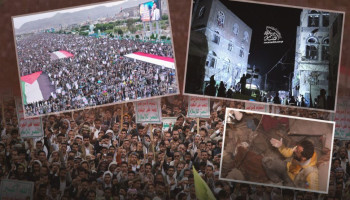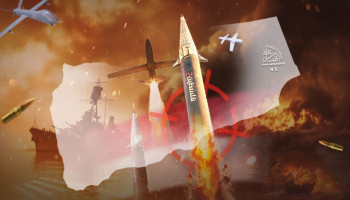While the mercenaries of aggression are busy with the bloody conflicts among themselves in the occupied southern regions, and the people of Yemen are struggling for their livelihood due to the aggravated suffering from the Saudi-led aggression and siege, foreign forces continue to arrive in the country to loot its wealth. This military presence of foreign forces has become public after it was going on secretly over the past years. Of course, this was done with the help of the Saudi-Emirati occupation and with the complicity of their local mercenaries.
 Photo of a French delegation in Yemen's Shabwa
Photo of a French delegation in Yemen's Shabwa
The American, British and French forces recently announced their presence in the eastern regions of Yemen, far from any cover-up, which Western countries used to practice to conceal their role in Yemen.
US President Joe Biden had informed Congress on the 12th of last June of his intention to deploy US forces in Yemen. Days later, the governorates of Mahra, Hadramout and Shabwa witnessed frantic movements of US, British and French forces.
These field movements of the invaders were launched - according to observers - by storming the house of the leader of the popular resistance in Al-Mahra Governorate, Sheikh Ali Salem Al-Huraizi, in the presence of American and British officers for the first time. These movements are to control the wealth of a country whose people are groaning under the weight of poverty and suffering.
The former Yemeni Foreign Minister, Abu Bakr al-Qirbi, revealed in a tweet on his Twitter account, last Wednesday, that “a corps of French forces” arrived at the Balhaf port for exporting Yemeni liquefied gas.
The arrival of the French forces to Balhaf - according to observers - represents a dangerous precedent on the scenes of Yemeni events, as France has never expressed any position against converting the Balhaf facility to export liquefied gas into a military barracks at the hands of the Emirati occupation forces, although France owns (39.62) %) of the Yemen Liquefied Gas Company, but Paris turned a blind eye to the exploitation of French investments for illegal purposes by Abu Dhabi, before the French government moved in a way that seemed inconsistent with its previous positions and decided to send its forces to Balhaf, in an act that carries many negative indicators towards the possibility of stopping the war on Yemen.
 Photo of an American delegation in Hadramout Yemeni province
Photo of an American delegation in Hadramout Yemeni province
Last Monday, the United States sent a team of military experts to conduct further studies on the location where the American forces plan to establish a military base in Hadramout.
Observers believe that Western countries are heading to deal with the Yemeni wealth of gas and oil as a “wealth without an owner” by dealing with a “government” that does not have any legal capacity to represent the people of Yemen, set up by the aggression to pass foreign ambitions in Yemen, outside the principles of international law, and respect for the sovereignty of Countries.
The Elimination of Regional Agents and Local Tools
Observers and political analysts assert that the approaching winter, in light of the fuel crisis that the West is suffering from as a result of the repercussions of the Russian-Ukrainian war, has prompted NATO countries to search for solutions to their problems by occupying the oil areas in Yemen.
Observers believe that the United States and Britain worked to prepare the situation in Yemen for the direct presence of their forces, by pushing a foiled coalition led by the Saudis and Emiratis, whose behavior deliberately provoked the wrath of the Yemenis, allowing the opportunity to let the original occupation, represented by the Americans and British, attend and announce the end of the tools phase. This also reveals to the Yemenis and the world that Washington and London have become part of the crisis in Yemen.
An official in the US State Department had explicitly announced in March last year while talking about “the withdrawal of foreign forces from Yemen, with the exception of some important areas,” as he put it, which indicates the intentions that the United States had towards Yemen, before it was disclosed explicitly within the last two months.
Experts and political analysts unanimously agree that Washington is leading the war on Yemen, and its eyes are directed toward controlling the shipping routes in the Red Sea, Bab al-Mandab and the Arabian Sea, in addition to its ambitions to dominate Yemen's oil wealth.
Tremendous Wealth
American, European and Russian economists and companies that have entered Yemen are unanimously agreed that there is a huge stockpile of oil wealth in Yemen, estimated according to official sources at 11.950 billion barrels, of which it is known and proven to be around 3 billion barrels of oil in Shabwa-Marib, and in Sayun, which places the country in the 29th rank in the classification of oil reserves, meaning that only 20% has been extracted from them so far, while more than 80% of the sedimentary basins are still promising and qualified areas for the formation of an undiscovered petroleum system, specifically in the Jaza’ basin, Qamar and between Mahra, Hadramout, Marib and Al-Jawf, which oil and geologists describe as “Siberia of Yemen,” not to mention the submerged basins, such as the Socotra Basin and the Red Sea (Thama) basin.
Unofficial sources indicate that Al-Jawf Governorate alone in the northeastern part of Yemen on the border with Saudi Arabia is floating on a lake of oil, with a bulky stockpile.
Yemen's huge oil and gas reserves are one of the causes of international and regional conflict in it, according to economists. Yemen also has important strategic ports overlooking the most important international corridors and deep waters connected to the Indian Ocean, and by this we mean the ports of Hodeidah, Aden, Mukalla and Nishtun. If these ports were properly used, they can constitute in being one of the most important sources of Yemeni national income.
Before the US-Saudi aggression, Yemen's production was 127 thousand barrels per day, representing 70% of the resources of the general budget and a large proportion of foreign exchange resources, according to official sources in the National Salvation Government in the capital, Sana'a.
The countries of aggression are currently controlling the oil regions in the country, specifically in the southern and eastern governorates of Yemen, and from the beginning they have disrupted the oil export pipeline that extends from Safer in Marib to Ras Issa port in Hodeidah, to deprive the areas under the control of the Supreme Political Council of their rights, and stop salaries of more than two million employees in the official sector as a means and tool of war, in addition to transferring the operations of the Central Bank from Sana’a to Aden, imposing a blockade on the port of Hodeidah and Sanaa airport and raising the customs dollar, meaning that it stripped Sana’a of most of the country’s revenues, which amount to more than 80% of the general budget revenues.
In this context, informed sources in the Ministry of Oil and Minerals of the Salvation Government confirm that the oil quantities looted by the Saudi coalition countries and the mercenary government exceeded $20 billion during the past years, part of which is used to finance the aggressive war, while the largest share goes to the accounts of prominent mercenaries and the ٍSaudi National Commercial Bank.
The sources indicated that some companies, such as the Cypriot "Calvalley" company and the Austrian "ONB" company, which are linked to the UAE "ADNIC" and Saudi Aramco, are cooperating with Yemeni traders who are directly involved in the smuggling of Yemeni oil through the Al-Nashima port in Shabwa, at a rate of 3 million barrels of oil per month.
However, the mercenary government is rushing to negotiate with international parties to obtain a loan of $2.5 billion, in exchange for the crude oil revenues, and offering some oil sectors for investment in front of foreign companies. However, all these loans, gifts and grants received by the mercenary government are going for personal accounts, and do not benefit civilians in mercenary-controlled areas that are witnessing difficult living conditions.
Sana'a and the People's Sovereign Rights
The authorities in Sana’a have repeatedly affirmed that restoring and liberating the sources of wealth is a sovereign right of the people that cannot be waived. Recently, the “Marib Initiative” raised the necessity of restarting the Safer-Ras Issa pipeline, pumping and exporting oil, operating the Marib gas station, and distributing oil and gas shares equally among all governorates , while giving the sons of Marib an advantage in jobs and wealth.
This expresses the conscience of the Yemeni people, who are suffering the worst humanitarian crisis in the world and eagerly yearn to restore their wealth and national decision, which forces the revolutionary and political leadership to move forward with the option of liberating all oil provinces and every inch of the country from the invaders and occupiers. Nevertheless, this worries Washington and Paris, who are keen to keep the geopolitical map drawn by the war as it currently is, by removing Sana’a from Marib and the southern governorates, where oil and gas are located, and where the American “Hunt Oil” and “French Total” companies are located. However, the Yemeni army has the power of deterrence, which makes it confident of Allah's victory in the battle of liberation.
Sana’a’s assurances, made several times, came from President Mahdi al-Mashat, head of the Supreme Political Council, Supreme Commander of the Armed Forces, as well as the head of the national delegation in the peace negotiations, Mohammed Abdulsalam, and the Minister of Defense in the Salvation Government and others, that companies looting Yemen’s wealth will not be immune from military targeting. This option was made as an urgent need because of the current events on the ground and the enemy must realize that this is a real threat.









